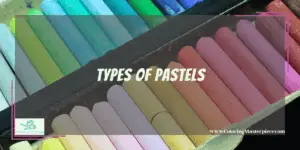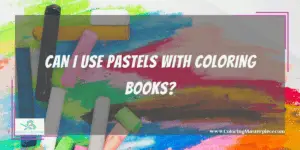Pastels are a dry medium capable of creating brilliant and vivid colors. They are incredibly versatile and can be used to create beautiful artwork. But can pastels be used with water?
Pastels can be mixed with water to create beautiful depth and shading and can even be used similarly to watercolor paint. While their bright and dynamic color may appear to be more like acrylic paint, they can be mixed with water and used like watercolor paint. They afford the artist a bit more control over their desired effect and can be used to create lovely layers and texture.
Depending on how much pastel pigment and water you mix, you can control how dynamic your tints and shades look. With pastels, you can control how much of your original lines you want to be retained.
When experimenting with pastels and water for the first time, you may want to start with less liquid than you think you need. You can always add more water if needed, but you can’t take it away. Plus, you don’t want to saturate your paper over and cause it to pucker or rip.
Typically sold in sets, pastels are easily portable, making them an excellent option for the home studio or taking on location. With a little care, your pastels can last a long time – they won’t dry out like paint.
Pastels are incredibly versatile and come in several different varieties, each with its pros and cons. Like paint or markers, there are many types of pastels, including both oil and water-based. Different kinds of pastels can be mixed with water to create lovely shading and other effects. It’s also a great way to blend colors; while some blend better than others, adding a little water will help you achieve your desired effect.
Types of Pastels

Pastels, no matter the type, often come in box sets such as the one seen above.
Soft Pastels
Soft pastels are the most commonly used variety; most people think of when one mentions pastels. They look similar to sticks of chalk, which is, in fact, usually one of the main ingredients along with pigment and a binder. Soft pastels are water-soluble and blend easily with water. Soft pastels are available in either square or round shapes. Which shape is best comes down to the artist’s personal preference. You may find it easier to do intricate line work or write fonts with square pastels, but these fun tools are so versatile you can get very creative with either shape. The possibilities of soft pastels are endless. If you are more traditional, you can draw your lines and color in shapes using the pastel, and then softly blend your work with a damp paintbrush, cotton swab, or another blender to create your desired effect.
Their soft texture and residual dust make it very easy to blend pigments and create rich color combinations or layer them on top of each other. It doesn’t take much water to soften your lines and give your art a watercolor effect; you can control how hard or soft you want your edges to appear based on how little or how much water you add. You can also trace over your finished pastel project with ink, a charcoal pencil, or hard pastels to reinforce some of your lines’ integrity if they get too watery – take it as an opportunity to have fun getting creative with more mediums.
Suppose you feel more adventurous and are looking for more of an authentic painting experience. In that case, you can use pastels with your hard plastic or ceramic artist’s palette and some water to effectively create your paint. Create some pastel pigment dust in one of the cups (you can try coloring a few strokes or gently use a knife to scrape some off) and slowly add water until you achieve your desired thickness. Then using a brush, blending tool, or even your fingers, you can color with your pastel mixture just as you would paint! This is a great way to get creative with the pigment and craft your unique colors.
Hard Pastels
While still chalk-based, hard pastels contain a higher percentage of the binding ingredient (most hard and soft pastels use gum Arabic as a binder – the same ingredient found in watercolor paint), making them more challenging and less crumbly or dusty. The texture of hard pastels is similar to that of compressed charcoal, and its rigidity makes them particularly useful for outlines and other intricate detail work.
Some artists like to reevaluate and outline their finished product after creating their pastel and water masterpieces. You can use water combined with soft pastels to create the soft and dreamy masterpiece you desire. Once the water dries, you can use a hard pastel, charcoal pencil, or regular ink to provide some definition to your pastel dreamscape.
Since they lack the residual dust of their softer counterparts, hard pastels are a bit cleaner to color with, yet this does make them harder to blend at the same time. Don’t be afraid to get creative and blend mediums; various lines, layers, and textures will only bring more depth to your piece.
Pastel Pencils
Pastel pencils look and work like colored pencils, but their soft texture places them in the pastel family. Like hard pastels, they are less crumbly than soft very portable,e and work very well for intricate detail work. While harder to blend due to their rigidity, you can still trace over your pencil lines with a damp paintbrush or cotton swab to play with your color and shading.
Water Soluble
While pastel pencils work similarly to a colored pencil, water-soluble pastels more closely resemble a crayon. They are entirely dissolvable in water, which makes them ideal for painting or blending colors.
Oil Pastels
Oil-based pastels are generally the hardest to blend because oil and water famously don’t mix. The composition of these pastels differs quite a bit from their soft counterparts; they’re made from oil and wax in addition to the pigment. The closest pastel to acrylic paint, they create art that is very fluid and can smear easily.
Interested in learning more about oil pastels? Check out our article here!
What Kind of Paper Should I Use?
It’s best to use these unique tools with proper pastel paper, which should be thick and textured enough to absorb the pigment and make it pop. Also called ingris paper, you can buy pastel pads or individual sheets of paper.
Can I Use Pastels with Coloring Books?

With some care and intention, you absolutely can use pastels in the intricate designs of adult coloring books, although you may want to take care to choose a book made with thicker, more textured paper.
Soft, dusty pastels are a great way to color in the background of coloring book art. Using wide lines with lots of space between them, you can use a small, damp paintbrush to blend your color across the page.
Pastel pencils are also a great option for coloring books, given their penchant for small shapes. Their chiseled tips allow the artist to be more intentional about their lines and detail work. To create more of a watercolor effect, try using a moist cotton swab to soften your lines and blend colors. You can also use traditional colored pencils on top of your pastel to create more elaborate shading.
Frequently Asked Questions
Do I need to do anything special to preserve my pastel artwork?
Since pastels are so soft and dusty, you may want to seal your finished project to prevent it from smearing or smudging in the future. A fixative also adds additional layers of depth to your art piece. You can either use a professional fixative from an art supply store or regular hairspray (although the hairspray spray may linger longer on your paper).
Whichever option you choose, make sure you spray your piece while holding the can at least a foot away while using a light touch. Remember, less is more; you can always add more sealant, but you can’t take any away if you use too heavy a hand.
Are pastels non-toxic and safe to use?
With a texture somewhere between chalk and clay, coloring with soft pastels does create some dust. The residual dust makes it easy to blend colors using your fingers or a damp paintbrush. Just take care not to smear it accidentally and smudge your artwork.
Due to the particles kicking up when using pastels, you might want to wear a mask while working with them (similar to those worn by commercial painters) or make sure to work in a well-ventilated room. Depending on your workspace, you may want to put down a drop cloth or newspaper underneath your artwork – especially if using oil-based pastels – and wear a smock or work shirt.
Loved this article. Click here to download my free adult coloring eBook and sign up for my email newsletter!
Disclaimer: The information provided by ColoringMasterpiece.com (“The Site”) is for general informational purposes only. All information on the Site is provided in good faith, however, we make no representation or warranty of any kind, express or implied, regarding the accuracy, adequacy, validity, reliability, availability, or completeness of any information on the Site. Under no circumstance shall we have any liability to you for any loss or damage of any kind incurred as a result of the use of the Site or Reliance on any information provided on the Site. Your use of the Site and your reliance on any information on the Site is solely at your own risk. This blog post is for educational purposes only and does not constitute legal advice. Please consult a legal expert to address your specific needs.
Terms and Conditions: https://coloringmasterpiece.com/terms-and-conditions/
